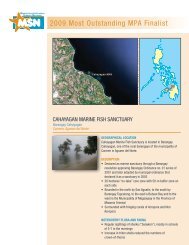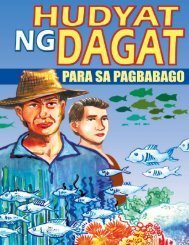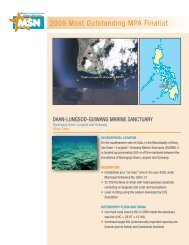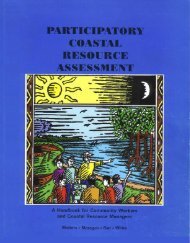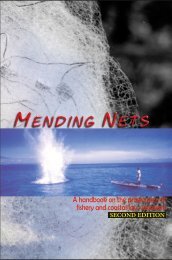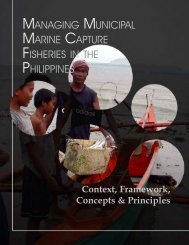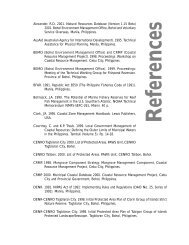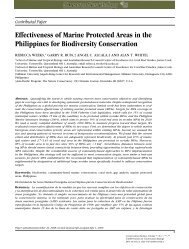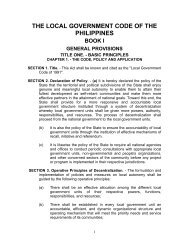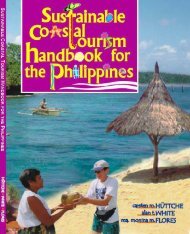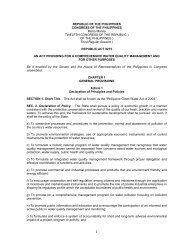3.9MB / Click here to download - Oneocean.org
3.9MB / Click here to download - Oneocean.org
3.9MB / Click here to download - Oneocean.org
You also want an ePaper? Increase the reach of your titles
YUMPU automatically turns print PDFs into web optimized ePapers that Google loves.
16 Rhythm of the Sea<br />
Local uses of mangroves are for poles for fencing and fish weirs, as well as for<br />
charcoal and firewood. While wood is cut for the construction of bancas (boats) and<br />
houses, t<strong>here</strong> is little or no extraction of timber by commercial establishments. The fruits,<br />
bark and leaves are used for food, medicine and animal fodder. Fish and crustaceans are<br />
captured in the fringes of mangrove areas and some areas within the habitat are used for<br />
the illegal construction of fishponds, especially for milkfish and prawns. Additionally,<br />
many fishing communities realize the importance of mangrove stands as a buffer against<br />
coastal erosion caused by incoming waves, especially during the peak typhoon season of<br />
September-January.<br />
Mangroves help <strong>to</strong> sustain coastal fisheries by providing feeding, breeding and<br />
nursery grounds for fish and for invertebrates such as shrimp and mollusks. Detritus and<br />
nutrients that accumulate from litter of decaying plants are consumed by marine <strong>org</strong>anisms,<br />
or exported by tides <strong>to</strong> nearby aquatic ecosystems. In addition, silt and sediments are<br />
trapped as they come from the land and help prevent erosion of the shoreline (B2DMP<br />
1997). Mangroves also support reptiles, amphibians and other wildlife, and serve as a<br />
potential source of materials for the production of pharmaceuticals. Invertebrates in the<br />
mangrove areas are gleaned during low tide.<br />
Mangrove-associated flora in the profile area consists of 2 species of algae (Bostrychia<br />
and Padina) and 6 species of seagrasses. Mangrove soils are basically sandy and of various<br />
grades; t<strong>here</strong>fore, Rhizophora is the dominant vegetation. Sand contributes <strong>to</strong> the majority<br />
of mangrove soils in the Bohol profile area. The deposition of this substrate type is attributed<br />
<strong>to</strong> the tidal inundation of the weat<strong>here</strong>d fragments of corals and other materials from the<br />
seabed.<br />
In the past, white herons, wild honeybees, Philippine cocka<strong>to</strong>os, bats and monkeys<br />
used <strong>to</strong> inhabit the mangroves. Now, the increasing encroachment of humans in<strong>to</strong> mangrove<br />
areas has driven most of these animals away.<br />
Seagrass and Algal Beds<br />
The nearshore area is mainly a seagrass zone. Even the intertidal areas between small<br />
offshore islands are generally composed of seagrasses, followed by Sargassum beds and/<br />
or coral patches and reefs. Seagrasses favor sand and silt substrates, while the Sargassum<br />
usually colonizes degraded or dead corals and limes<strong>to</strong>ne.<br />
Seagrass beds in the profile area comprise approximately 555 ha found at depths<br />
of 0 <strong>to</strong> 3 m (SUML 1997). Six species of seagrasses have been identified in the profile<br />
area. These species are: Cymodocea rotundata, Enhalus acoroides, Halophila ovalis, Halodule<br />
pinifolia, Halodule uninervis and Thalassia hemprichii. Sargassum beds dominate at deeper<br />
depths with a biomass of approximately 37.25 g dry weight/m 2 . It is seasonal and most<br />
abundant from April <strong>to</strong> Oc<strong>to</strong>ber.



